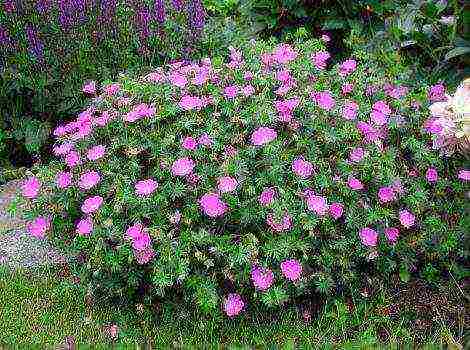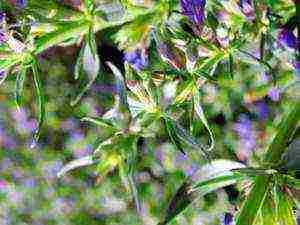Content
The snow has not yet melted, and sprouts are already peeping out from under last year's grass on the lawns. These are the firstborns of spring - crocuses. Planting and care in the open field will not take a lot of time from the gardener. The origin of the crocus is the Mediterranean, Southern Europe, the Caucasus, but in the middle lane and in the North-West of Russia crocuses grow, bloom, they are quite comfortable if you pay attention and care to flowers. Crocuses are corms, perennial ephemeroids, they delight with flowering only for a short time, and spend most of their lives at rest, sleeping in the ground. Despite the long sleep, crocus is one of the most beloved and widespread early flowers, a miracle of spring!
There are autumn flowering crocuses. They bloom in the fall, after the foliage has fallen. The disadvantage of autumn crocuses is that the flowers open in sunny weather. If it is cloudy and rainy, you may not see the bloom. Some autumn varieties bloom late, summer cottages are already empty and the fall's farewell gift goes unnoticed.
Rules for planting crocuses in open ground
Biological characteristics of crocuses
In the underground part of the plant, the corm, which looks like a bulb, the plant makes a strategic supply of food that helps to survive a long period of dormancy. Spring crocuses first release flower stalks, then foliage grows, which develops completely after flowering. By the end of the growing season, it dries up. At this time, one or more young replacement bulbs grow over last year's old corms. The complete death of foliage means that the crocuses have retired. This is the best time to transplant them, divide nests. Do not delay the transplant, later, in August-September, fragile roots will begin to grow, which are damaged during transplantation.
Choosing a place and soil for planting crocuses
For crocuses, sunny warm meadows are chosen, where they bloom before anyone else. Planted in partial shade, on the northern slope, the plants will bloom 10-15 days later, which is not bad, their flowering time will last. Crocuses will like the neighborhood with perennial shrubs, their blossoming leaves will cover the withering foliage of the crocuses. But with strong shading, crocuses do not bloom well, the flowers become smaller, the bulbs cannot accumulate sufficient food for future flowers.
Crocuses grow up to 4-5 years without transplantation, then they become cramped.
Flowers love loose nutritious soil, good moisture. Crocuses do not need watering, usually they have enough moisture after the snow melts. Fertile soils are good for them, but if the soil is not "greasy" enough, top dressing will fix it. Spring crocuses do not grow well on acidic soils, autumn crocuses, on the contrary, like sour soil, it is good to add peat under them. For those and others, stagnant water is destructive. The site must have good drainage, the bulbs rot in dampness.
On clay soils, heavy loams, sand, humus, compost are introduced. For 1 sq. meter - a bucket of sand, half a bucket of organic matter plus a complex mineral fertilizer. Fresh manure is contraindicated for crocuses, it can provoke the onset of diseases.
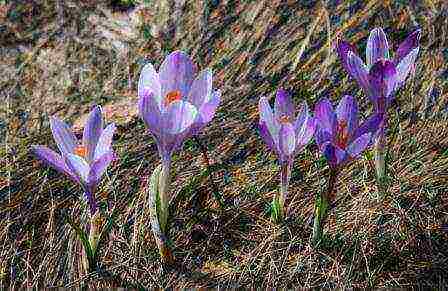
Crocus vernus - Spring crocus
Preparing the bulbs for planting
When buying, the bulbs are examined - they should not be soft. Good bulbs are firm to the touch, weighty, without rot, damage or stains.The size of the bulbs is up to 3 cm in diameter, if larger, most likely an error has occurred, these are not crocuses, but crocuses. It is not necessary to soak healthy bulbs before planting, but it is worth treating them with a remedy for fungal diseases for prevention, or with a pink solution of potassium permanganate. Dilute "potassium permanganate" to the desired concentration in warm water and place in a solution of corms for 25-30 minutes. They take them out, let them dry and plant them in the ground.
Rodent protection
Crocus bulbs are a tasty dish for mice and voles. It is important to protect the planting from rodents, otherwise the corms may disappear, and with them the gardener's work will go to the mice for lunch. It's good when a cat lives in the house, let him walk on the site. They resort to special scarers, treat the bulbs before planting with strong-smelling substances (Vishnevsky ointment, kerosene, tar). Care must be taken here so that the planting material does not burn.
To destroy rodents, poisoned baits are laid out, bulbs are planted in special plastic baskets. To do this, half of the soil is poured into the basket, the onions are planted, and then the whole basket is planted in the ground in the prepared hole, covered with soil.
Crocus planting
Crocus planting is a simple process. Spring crocuses are planted earlier than other bulbs - in September. Autumn views - at the end of August.
Crocus corms are planted to a depth equal to the height of two bulbs, in increments of 10-15 cm. It is better to sort the corms by size and plant about the same side by side, the flowering will look more amicable. After planting, watering is carried out, the soil is mulched with peat, humus.
In order not to lose the crocus bulbs when digging up neighboring plants, digging up the soil, plant them in rings from plastic bottles cut off from above and below. With this method of planting, it is the crocuses that will receive top dressing, the bulbs will not be lost, the weeds will oppress them less, the ring will serve as protection from rodents.
Crocus speciosus - Beautiful Crocus
Landing on the lawn, care
Crocuses look amazing in a continuous planting on the lawn. But with active use of the lawn, crocuses will not withstand trampling.
To plant crocuses on the lawn, plant the bulbs according to the 10x10 cm scheme. This action is carried out using a narrow garden scoop or knife. With its help, a piece of sod is cut and taken out, an onion is planted and the sod is returned to its place. The planting is well watered.
Crocuses are planted on the lawn in separate curtains. The sod is cut in the shape of the letter "H" and carefully turned away. Mineral complex fertilizer is poured onto the opened soil, humus is poured, gently loosened. The bulbs are planted at a distance of 5-7 cm, slightly pressing into the ground. The turf plates are laid in place, watered.
Crocus lawn maintenance is complicated by the fact that it cannot be mowed immediately after the crocus bloom. But you can mow the lawn without waiting for the crocus foliage to dry out completely. This is done a little later and at a higher than usual height. At the same time, the bulbs will have time to accumulate the nutrients they need. If crocuses do not grow entirely, but in curtains, you can leave them unmown. Top dressing of the lawn with complex fertilizer with microelements is mandatory in the care process, it will benefit both the lawn grass and the crocuses.
The first feeding of crocuses with full complex fertilizer with microelements is carried out when the snow melts, then - during the period of leaf regrowth.
When crocuses grow in the vicinity of perennial shrubs and trees, when they are fed, they will also feed on the bulbs.
For the winter, the planting sites of corms are covered with a layer of foliage, but this technique is optional, crocuses are quite winter-hardy. It is much more important to have a shelter from above for the successful wintering of crocuses, good drainage, the absence of stagnant water.
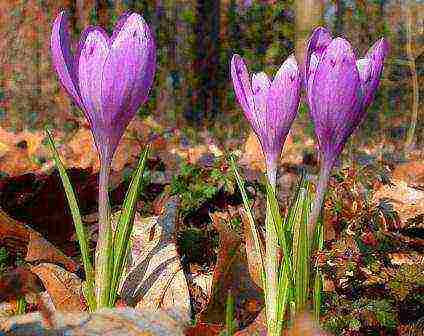
Crocus heuffelianus - Crocus Heuffel
Crocus reproduction
The usual way of breeding crocuses is by daughter corms. Under favorable conditions, up to 10 of them are formed around the mother. It is not surprising that crocuses grow rapidly and after 4-5 years they become cramped.
When the leaves dry up, during the summer sleep period - from July to August - the bulbs of spring crocuses are dug up. For autumn digging periods - from June to mid-August. Corms are selected from the ground, dried in the shade for several days. Disassemble them, removing scales with defects, dried roots, separate the children. Rotten, badly damaged, crumpled, diseased bulbs are discarded. Healthy planting material is stored in a dry and warm, ventilated place at a temperature of 22-24 degrees. At temperatures below these, bud formation in the bulbs will slow down, and crocuses may not bloom.
If you want to multiply crocuses as soon as possible, you should not wait 4-5 years, you can dig up and replant the bulbs every year. The main thing is to do it on time, not forgetting about the rest period. The planted crocus babies will bloom in the second - third year after planting.
Seed propagation of crocuses
Crocuses are also propagated by seeds, if you wish, you can quickly multiply a particularly valuable species, get a lot of planting material at the same time. Fresh seeds are sown in autumn. Seeds are laid out on the prepared substrate of peat, humus and sand in equal parts, covered with soil with a layer of no more than 1 cm. They are sown infrequently, so that the seedlings do not have to dive. After natural winter stratification, friendly shoots appear. Since the plants are very small, it is best to sow the seeds in containers or boxes so as not to lose.
With careful care, protection from weeds and pests, regular watering and feeding, corms are formed in a year or two. In July, they are dug up, and in August they are planted in a permanent place. In another year, the crocuses will bloom. Reproduction of crocuses by seeds is a painstaking and troublesome business, they rarely resort to this method.
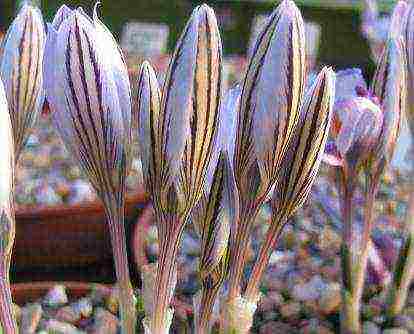
Crocus reticulatus - Netted crocus
Crocuses in landscape design
Crocuses are beautiful in bloom, they are planted everywhere: in groups in curbs, rabatkas, on alpine hills. Crocuses look great among stones that set off their tenderness.
They are planted between trees and bushes, among perennials with late growing foliage (hosts, for example), they will cover the withering leaves of crocuses, preserving the decorative effect of the planting.
Dutch crocus varieties can be used to create wonderful multi-colored patterns on the lawn, it all depends on the gardener's imagination.
Crocus bulbs are used for forcing for the holidays: New Year, March 8 and others. For these purposes, large-flowered hybrids of Dutch selection are used.
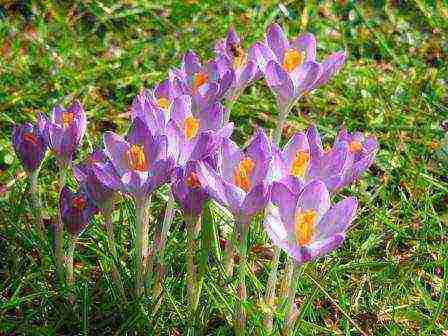
Crocus tommasinianus - Crocus tommasini
How useful was the information for you?
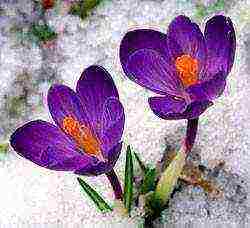 Crocuses are early spring perennial bulbous plants. The color combinations of these spring flowers delight and delight eyes and heart tired after a long winter. Under natural conditions, the cultivation of these bulbous perennial plants is carried out on sandy, stony and loose soils. Planting and care is carried out in sunny areas in the open field.
Crocuses are early spring perennial bulbous plants. The color combinations of these spring flowers delight and delight eyes and heart tired after a long winter. Under natural conditions, the cultivation of these bulbous perennial plants is carried out on sandy, stony and loose soils. Planting and care is carried out in sunny areas in the open field.
Crocuses: varieties and varieties
The homeland of these perennial flowers is European countries, North African states and western Asia. In addition to the remarkable property of pleasing the eye, the field of application of this plant is wide: crocus (or saffron) is used in cooking as a seasoning, as a dye and medicine. The selection has bred varieties with large inflorescences, differing in color: striped, spotted, two-colored, with a contrasting pattern. The reproduction method for preserving the variety of this plant is simple and quite accessible to gardeners.

Crocuses are among the first to bloom after winter.
Crocuses, the cultivation of which in modern conditions made it possible to obtain more than 250 species, differ not only in color, but also in the size of the stamens and pistils.
At the end of the 19th century in Holland, the reproduction of species contributed to the emergence of the crocus cultivar, but interest in it, as an ornamental plant, appeared much later. Together with this variety, such varieties as narrow-leaved crocus, yellow crocus and spring crocus were introduced into the gardens of Europe. It was thanks to these varieties that Dutch hybrids appeared.
Outdoor crocuses begin to bloom in late April - early May. These are cold-resistant plants, they tolerate frosts down to minus 5 - 7 degrees. Bright flowers of each variety delight the eye for 10-15 days. To extend the flowering period, it is recommended to use different varieties - early, medium, late. For example, in landscape design, spring types are now the most popular:
- Golden crocus "Blue Pearl" - small (2 cm in diameter) bowl-shaped flowers, white, pale blue hue. At the base, the flower has a yellow color. The pistil is large, much larger than the stamens, the anthers are cream-colored. Blooms early.
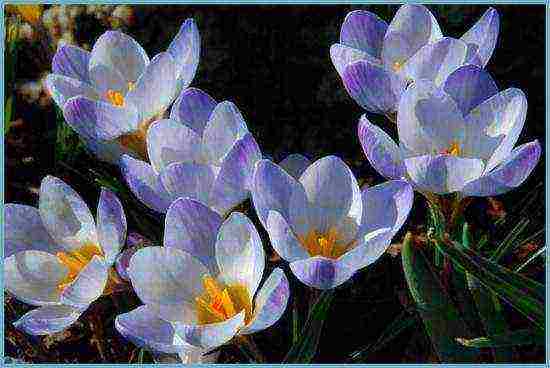
Blue Pearl variety
- Golden crocus "Saturnus" - The flowers are flat, oval, creamy yellow. The anthers are light yellow and the stigmas are reddish-orange. " Blooms in medium terms.
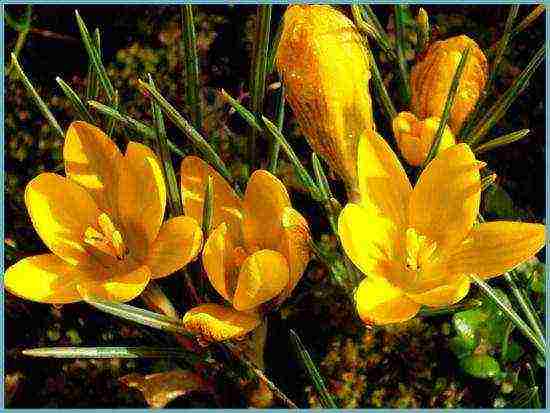
Saturnus cultivar
- Spring crocus "King of striped" - the color of its flowers outside is white-lilac, reticulate, anthers and stigmas are bright yellow. Flowers up to 4 cm high. Flowering at a later date.
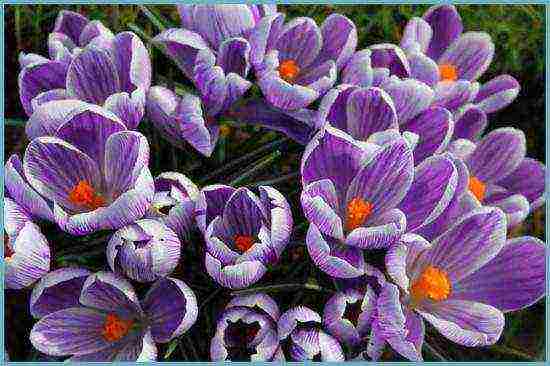
King of striped variety
- Spring crocus "Pickwick" - the flowers are large (4-6 cm), the color is light purple with purple spots at the base, the stamens are yellow, large. It blooms in late spring.
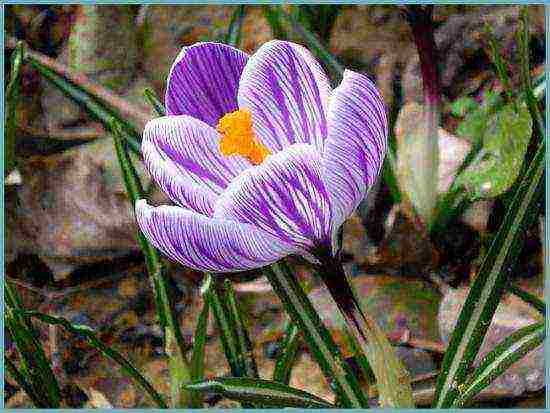
Pickwick variety
- Spring crocus "Grand Maitre" - this variety has large goblet flowers (4 cm), purple, saturated, pointed tops of petals, pistil and stamens are equal in height. A variety of late spring flowering.

Sort Grand Maitre
Planting a plant
Spring crocuses are planted in early autumn (late August - early September) at a distance of 7 to 10 cm from each other. Crocuses planted in September are not hardy enough, so they are covered for the winter in order to avoid freezing of the bulbs, which is quite dangerous on clay soils and loams. Dry foliage, peat and humus are useful for insulation.
In the planting area, recesses are prepared so that the bulb can fit freely. When planting tubers, the soil must be well fertilized with compost. A drainage is placed at the landing site, in order to avoid the accumulation of stagnant water and rotting of the bulbs. Expanded clay, screening, coarse sand are used as drainage. Then the top is filled with a fertile layer, mixed with compost.
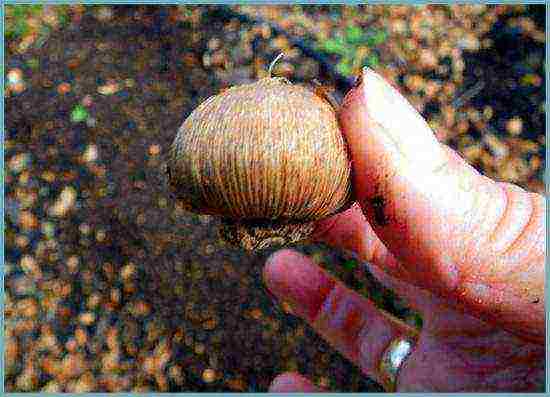
Crocus bulb
If the soil is fertile and well fertilized with compost, then in the first year after planting, no fertilizer is added, the next year potash and phosphorus additives are added to the soil. After planting, the rhizomes are covered by mulching the soil.
Crocus care
Taking care of a plant with proper planting is not difficult. Crocuses are sun-loving flowers; growing them outdoors in shaded areas leads to shredding of flowers or their absence. They are quite resistant to drought: in the spring, during flowering, there is enough moisture for the flowers, but in the summer, watering is still necessary.
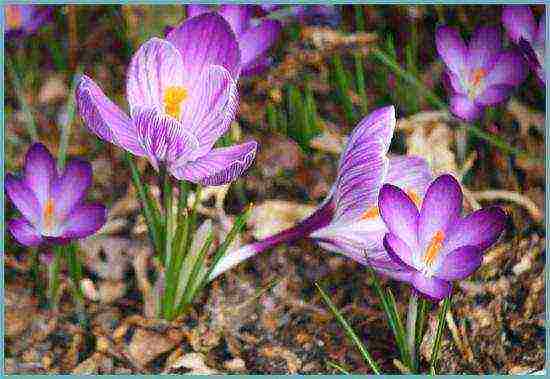
Your main task is to plant crocuses in a sunny area, and they will actively bloom.
Some hobby gardeners dig up crocus bulbs every year, dry them and store them in a cool place. This allows the selection of the largest perennial plants; such care saves the bulbs from rodents and decay.
Plant propagation
Crocuses breed mainly by children. Large daughter bulbs are carefully separated and planted separately. This allows you to preserve the grade of the perennial. To speed up the reproduction process, the bulbs should be dug up annually, since they are replaced every season: the old ones dry out, and up to five new tubers grow nearby.
For planting, the bulbs are chosen larger, the old dried and rotten lobes are cut off.In general, crocuses are unpretentious, you don't have to dig them out every year, but you don't need to keep the flowers in one place for more than five years, the plantings grow and bloom poorly.
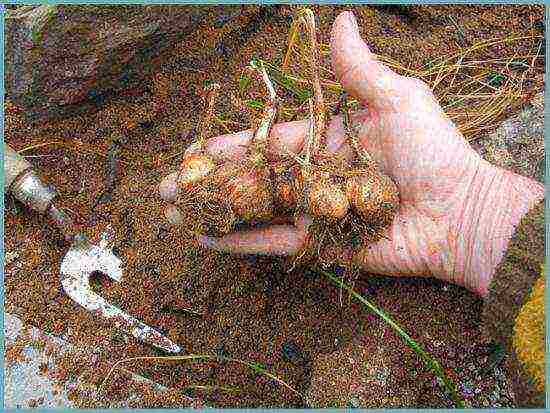
Propagation of crocuses by daughter bulbs
Dug up the faded plants in July, after the foliage dries up. Reproduction of saffron is carried out by seeds, but then the flowers will have to wait only in the third year. With this method of propagation, varietal characteristics are not always preserved.
Diseases and pests
The cultivated varieties and hybrids of crocuses are resistant to diseases, but in moist soils they are exposed to various viruses and fungal diseases. Diseases can be fought only, unfortunately, by the destruction of the affected bulbs, while the earth is spilled with a special solution. After the discovery of diseased bulbs, the cultivation of flowers must be carried out in another place.
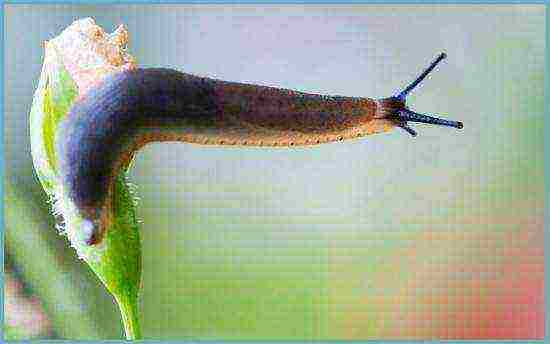
Slug
Crocuses suffer from invasions of moles and mice, but if flowers are planted on alpine slides and rockeries, then rodent protection is pre-installed there. Crocuses are also susceptible to attacks by slugs and scoop butterflies; to get rid of insects, they are regularly sprayed with insecticides.
Attention! With improper care, crocus flowers become smaller, lose their color intensity or do not bloom at all.
The use of saffron in landscape design
Crocuses, planting and caring for which are not very difficult, are now widely used in mass compositions when creating beautiful landscapes of gardens - in a mixborder, a rabatka or in a flower bed.

Monoplanting crocuses
Crocuses in groups with tulips, hyacinths and daffodils are simply irreplaceable for decorating a spring landscape. In the landscape design of the adjoining plots, crocus varieties are very expressively set off by stone compositions in rockeries and rock gardens, where their bright flowers stand out against the beige background of stones.
In rockeries and ridges, crocuses fit perfectly into compositions with undersized shrubs. Planting of these perennials with conifers and winter green plants, for example, in English style rockeries, will become a bright spring accent.
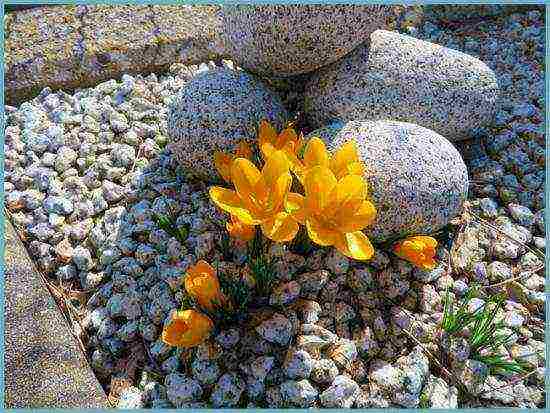
Crocuses in landscape design
Crocuses can also be planted on lawns, the combination of their delicate glasses with emerald grass looks good on the lawn, however, it will be possible to mow such a lawn only after the saffron foliage dies, otherwise every year there will be fewer flowers on the crocus. These plants are intended for growing in the open field, but they bloom wonderfully on the windowsills of apartments.
Advice! If crocus flowers appeared on the windowsill in the spring, then it is quite possible to extend their life by planting on the site and perfectly use it in the landscape design of the garden, but start planting in open ground no earlier than late May - early June.
Numerous photos of crocuses in group compositions with shrubs or other perennial bulbous representatives can be seen in a variety of literature on the design of garden landscapes.
Growing crocuses: video
Varieties of crocuses: photo
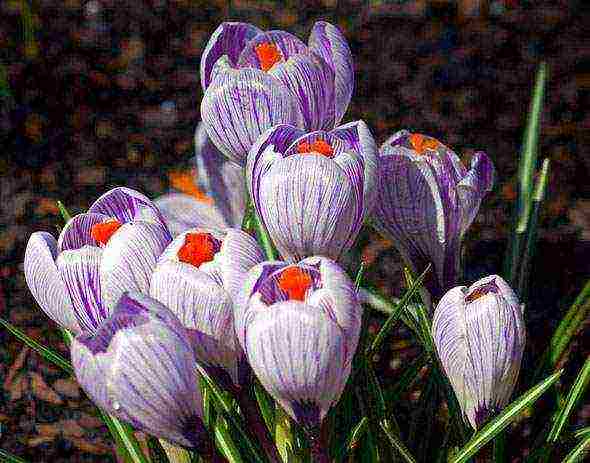
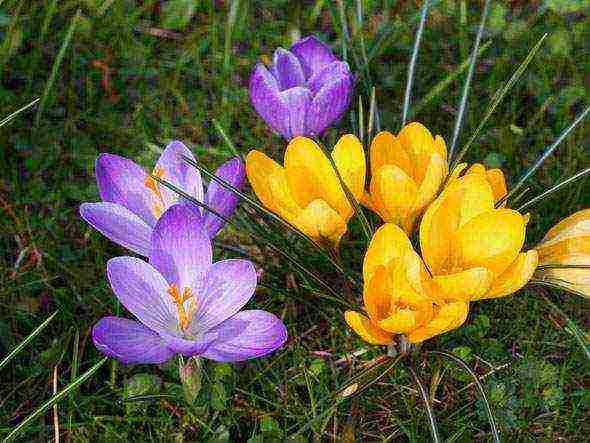
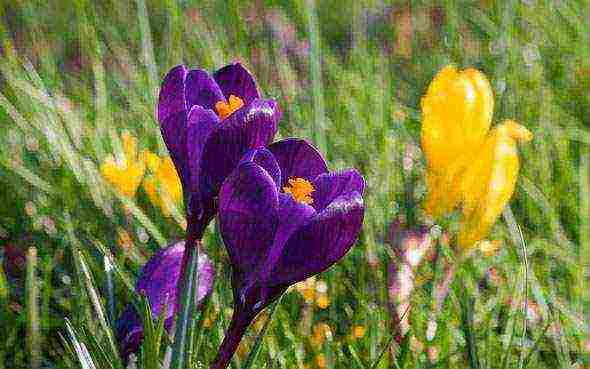
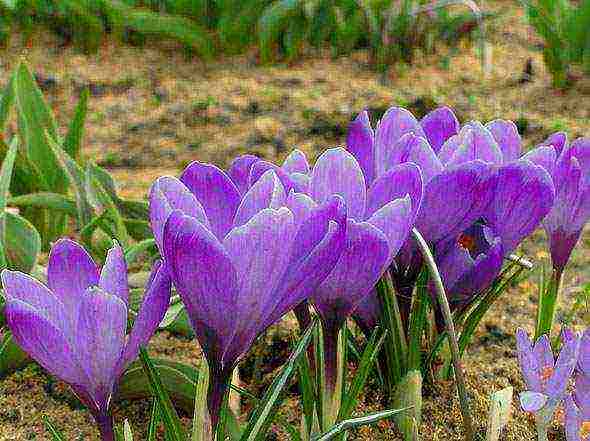


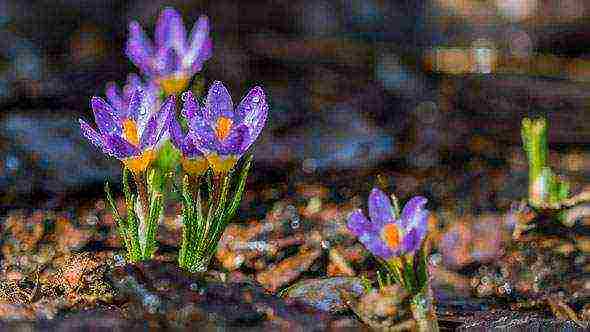
Beautifully flowering bulbous primroses are the dream of every grower. Crocuses do not require special skills in care. Therefore, even a beginner can do it.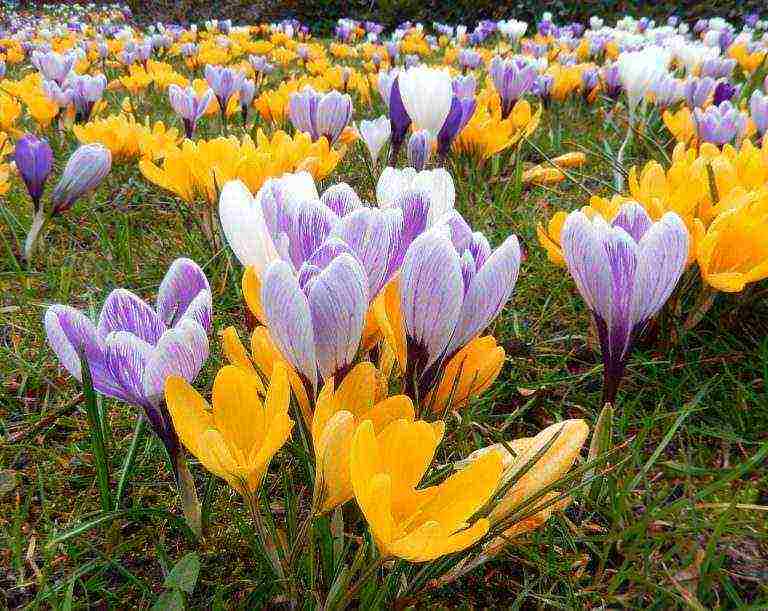
When is the best time to plant?
Crocuses are classified into autumn-flowering and spring-flowering varieties. Consequently, the planting time will be different for each variety.
- Spring varieties begin their development cycle in early spring, land in September... Plants grow green mass, bloom and retire. During this period, the bulb is still loose. Therefore, a recovery period passes before planting, and new children are formed. It is the spring varieties that are sold on store shelves.
- Autumn crocuses harder to meet. Their development period begins in September. Leaves grow, bloom until they leave under the snow with open inflorescences. Such species are planted in the second decade of July... The main thing is not to be late with planting flowers.Otherwise, the formation and education of children will not occur.
In autumn
- Crocuses can sit in one place for many years. And if you do not touch them, subsequent copies will be smaller every year. Because the kids are cramped.
- The annual separation of the babies from the mother bush will help to maintain good flowering.
- Autumn specimens begin to divide in the summer.
- A plot that meets all the requirements will give autumn bloom.
In the spring
- Spring flowering varieties are planted in September.
- The tubers rest at this time and accumulate strength.
- The first buds should be expected in April.
- In the fall, 14 days before planting, the soil is prepared.
- Humus is distributed throughout the site and the earth is dug up.
- Complex fertilizers should not be applied.
- After flowering, you must wait for the leaves to dry completely.
- The tubers are then dug up and stored in a cool place until September planting.
Choosing a landing site
- The area for crocuses should be sunny, as flowers prefer “sunny flower beds”. Here, the snow will melt first.
- Flowers do not tolerate cold winds.
- Shaded areas can affect the appearance of the instance. They will not be as colorful and bright.
- The second condition when choosing a site is a hill. Since in low places excess moisture can accumulate, which threatens the corms with decay.
- Bright bloom depends on one more factor - the soil. Crocuses thrive in loose and fertile soils.
If the area is clayey, be sure to add sand, manure and compost before digging it up.
How to plant outdoors?
- If planting material is purchased in a store, you should pay attention to some facts. The bulbs must be covered with the skin intact, without overgrown roots. Dark spots, mechanical damage, small size should not be present.
- Weighty specimens are considered a good sign.
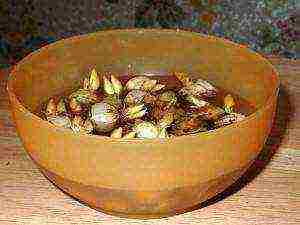 Soaking the bulbs in the solution The planting material is first sent to the fungicide solution. It can be Skor, Maxim, Fundazol. Follow the instructions for the selected drug.
Soaking the bulbs in the solution The planting material is first sent to the fungicide solution. It can be Skor, Maxim, Fundazol. Follow the instructions for the selected drug.- The soil is being prepared. If it is loamy or sandy loam, fertilizers are not applied. One digging of the site is enough.
- For a voluminous clearing, it is good to plant bulbs in steps of 3-5 cm.
- To calculate the planting depth, multiply the height of the bulb by 3.
- In regions with severe winters, additional shelter with fallen leaves or spruce branches will be required.
Distillation
- High quality corms are selected.
- Light moist soil is prepared in September or October.
- Planting material is placed more frequently than usual.
- The container is covered with foil and sent to a cold place, such as a basement or refrigerator.
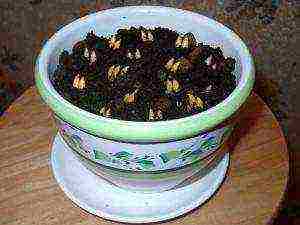 Crocuses are planted densely for forcing.The first shoots will appear in January.
Crocuses are planted densely for forcing.The first shoots will appear in January.- Then they are exposed in a room with a temperature of 15 ° C and shaded.
- Watering periodically.
- After 7 days, the film is removed.
- Apply additional lighting.
- The appearance of the first buds will be a signal to transfer them to a warmer place.
- In autumn, flowers are planted in open ground.
Care
- Plant agrotechnology is very simple.
- Plants are fed only during the period of active growth, alternating organic matter with mineral fertilizers.
- In dry weather, the flowers are watered.
- Autumn-flowering specimens are not dug for storage. This is done only for the purpose of dividing the uterine bush and babies.
- Spring-flowering varieties are dug out after flowering, when the bush is completely dry. Stored until September in a cool place and planted.
Diseases and pests
- Mice... They damage bulbs and are carriers of fungal and viral diseases.
- Wireworms... Holes from larvae appear in tubers.
- Slugs.
- Viral diseases... The carriers can be mice.
- Fungal diseases... It can be penicillous, sclerocial, gray rot, fusarium. Warm and damp weather is a favorable environment for the development of the disease.
How to fight?
- Mice... Crocuses should not be planted near uncultivated fields. Protect the seat with spruce branches. It is good to plant the crop in plastic containers. You can use scarers in the form of "turntables".
 WirewormsWireworms... Make depressions in the ground and spread straw or last year's grass and water. The larvae will gather in a warm place from where they can be removed and burned. The procedure is performed in April, in several approaches.
WirewormsWireworms... Make depressions in the ground and spread straw or last year's grass and water. The larvae will gather in a warm place from where they can be removed and burned. The procedure is performed in April, in several approaches.- Slugs... Regular collection of parasites.
- Viral diseases... The damaged instances are destroyed.
- Fungal diseases... They can be brought in with the purchase of planting material when mold or damaged tubers are visible on the tubers while digging out of the ground. As soon as you notice that the bulb is damaged, the wound should be treated with ash and dried for 7 days in a warm place. The disease can be avoided by periodically replacing the seat (once every 5 years).
What to do after flowering?
- Spring-flowering varieties are dug up after flowering and stored in a cool place until the next planting.
- Autumn varieties are not dug up until 4-5 years old, they winter in the ground.
Popular species and varieties
The Crocus family includes 80 species and more than 300 varieties, which, in turn, are subdivided into 15 groups. The first group represents specimens of autumn flowering (Chrysanthus), the second - spring flowering (large-flowered crocuses and Dutch breeding).
Among the garden varieties are:
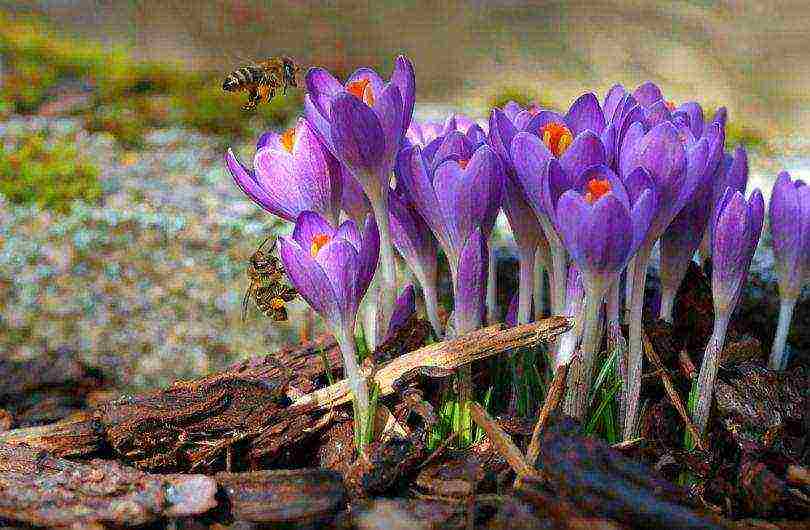
Crocuses are one of the very first spring flowers, well known to many gardeners and gardeners. Often they begin to bloom at the very beginning of April, when there is still snow on the ground, as if heralding the imminent arrival of spring with their flowering.
Growing crocuses does not require special knowledge and effort, although it will not be superfluous to know certain nuances of caring for these flowers.
When and how to plant crocuses
Crocus planting in open ground can be carried out in the fall for spring varieties, and in the summer if you plant autumn-flowering crocuses. Flowers require loose dry soil, and the site must have good drainage, which can be done from a layer of river sand or fine gravel.
In order for the soil for crocuses to be more fertile, it is worth adding compost or rotted manure to it when digging. If the soil is too clayey, then ash should be added to it. Autumn planting is carried out in September, with the bulb buried to a depth of twice its size.
Crocuses can also be planted at home in winter - the so-called distillation planting. For this, large-flowered crocus varieties are selected. The bulbs are planted in wide, shallow pots with neutral, loose soil.
After the potted crocuses have faded, the bulbs should be stored in a cool dry place until they are planted in the fall.

How to care for crocuses
For normal growth and development, plants need the following conditions:
- Watering is not needed if there was enough snow in winter and it rained abundantly in spring. Crocuses are drought-resistant flowers, so excess moisture can only harm them;
- Loosening is carried out necessarily and regularly. At the same time, the site is also freed from weeds;
- Top dressing - applied during active growth, for this you cannot use organic fertilizers, only mineral fertilizers, for example, phosphorus and potassium. The first feeding should be applied in early spring, the second during flowering.

How to care for bulbs
Every three to four years, crocus bulbs must be dug up for the winter. If we are talking about autumn flowering varieties, then this should be done in the period from June to August, and if about spring varieties, then from July to September.
Dug out bulbs should be dried, dead roots removed from them, diseased specimens should be removed, and all damage should be treated with ash or crushed coal. Bulbs should be stored in a cool, dry place prior to planting.
Crocuses are not afraid of diseases and pests; only rodents can harm them.To protect the planting material from them, you simply do not need to leave it unattended.
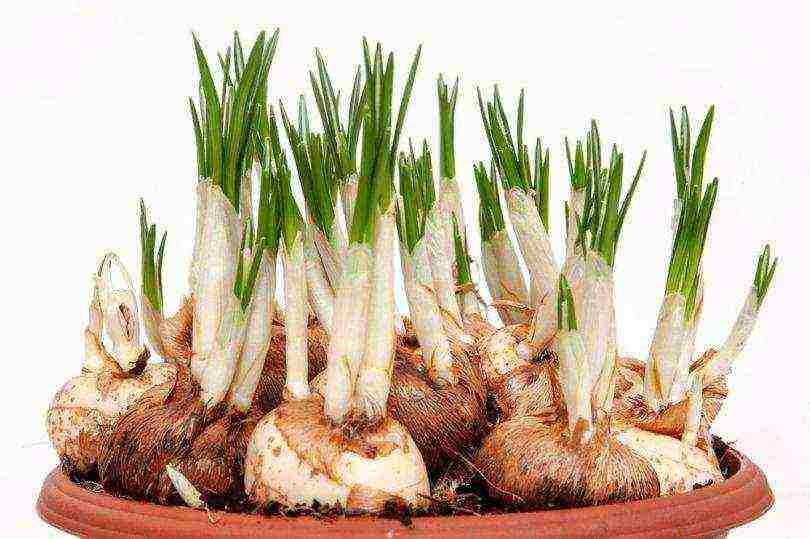
As you can see, crocus cultivation does not trump any special conditions and you can easily decorate your site with these delicate flowers.
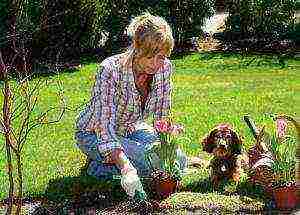
He spent most of his childhood at the dacha with his parents, from where he gained knowledge of gardening. The words "stalk" and "mulching" are as clear as "plinth" and "shtroblenie", as a couple of apartment renovations, done with my father, added knowledge in the field of construction and renovation.
Partners' news Editorial recommends

